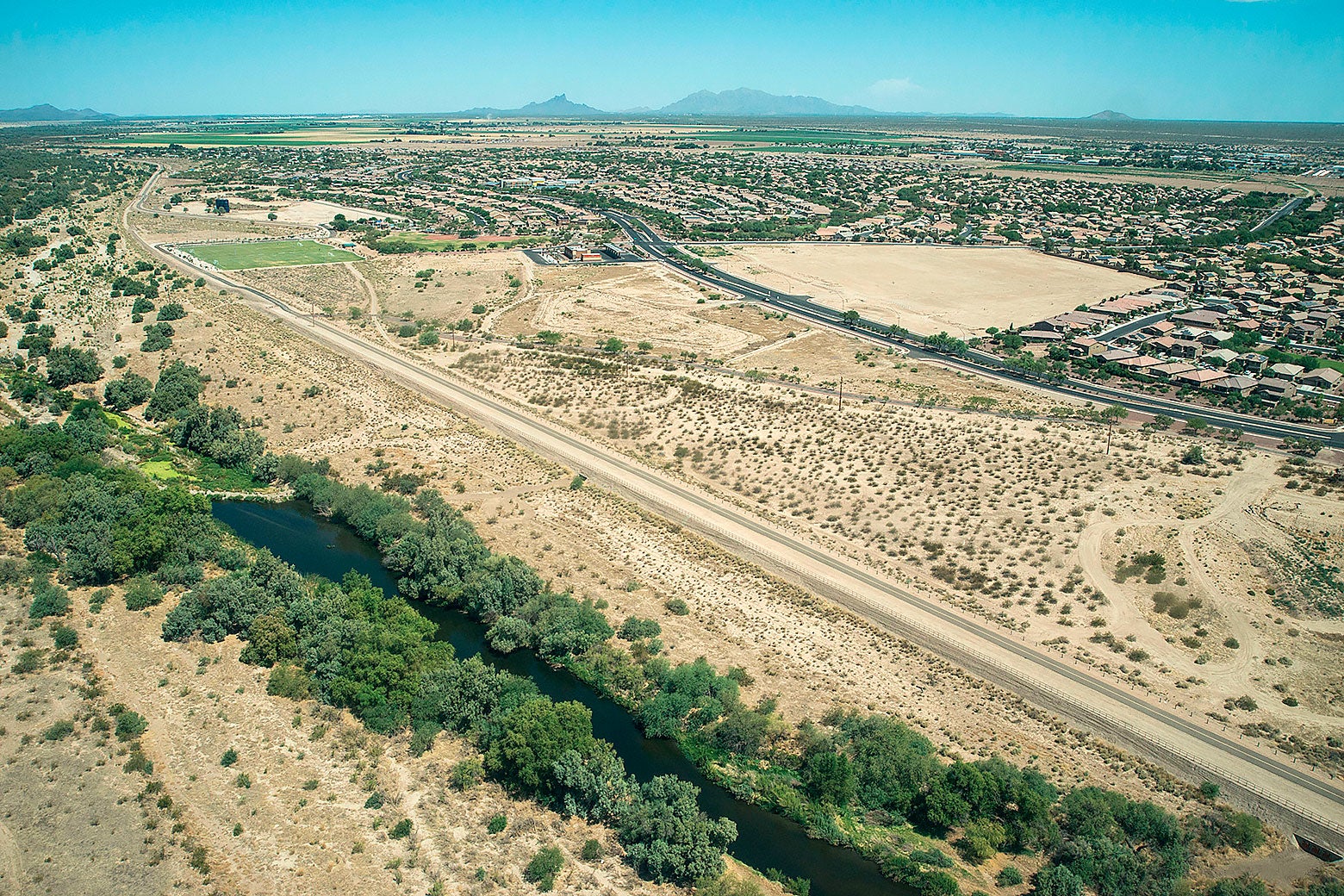
Sign up for the Slatest to get the most insightful analysis, criticism, and advice out there, delivered to your inbox daily.
The Sonoran Desert in southern Arizona is hot and sandy. But where the Santa Cruz River flows, you’ll find something like an oasis. Birds sing among dense copses of mesquite trees; flowers hang heavily from bushes; ocelots and jaguars pass through. You’d never guess that the river supporting all this life is entirely composed of wastewater.
Rivers in America have long featured wastewater—water that has been used in some way, like in a sink, shower, or toilet—as an ingredient. Before wastewater treatment became a thing, people used to dump their chamber pots into streets, where it mingled with stormwater and flowed into bodies of water. Treatment plants became more common in the late 1800s, but did little more than remove the solids before piping the rest out to the ocean, wetlands, and rivers; in many places, dumped sewage continued to go untreated through the 20th century. The rough idea was that clean water would dilute the dirty stuff. It was also convenient.
It came back to bite us, as these things do. An estimated two-thirds of lakes, rivers, and coastal areas were deemed unsafe for fishing and swimming. A river in Ohio caught on fire multiple times. A person needed a tetanus shot if they fell into the Potomac. The turning point came in the 1970s with the Clean Water Act, which introduced some of the first water pollution regulations. By then, new treatment techniques had also introduced processes to better treat the water before it was dumped into the environment, though its quality was far from perfect.
So, there being wastewater in the Santa Cruz River is not particularly surprising. What’s incredible is how healthy the environment in and around it is—and not only in spite of its wastewater inputs, but because of it. The Santa Cruz River dried up in the mid-1900s. It started running again some years later thanks entirely to wastewater inputs—but ran polluted due to the water’s relatively poor quality. When an eight-mile stretch of cottonwoods and willows suddenly died in 2005, it became clear that something needed to change. The wastewater treatment plants were finally overhauled with new technology that could remove the ammonia that was choking the river.
The resulting highly treated wastewater inputted into the river’s headwaters—roughly 15 millions of gallons are produced every day by the Nogales International Wastewater Treatment Plant—is now so clean that an endangered minnow recently returned to the waters for the first time in a century. “What we’re seeing is a profound change in this river system,” says Luke Cole, director of the Santa Cruz River Program at the Sonoran Institute. For the past 15 years, the river has been “pretty much doing great.” (That being said, its rehabilitation is in its infancy, which is why it was designated as one of America’s most endangered rivers in 2024. “This is a tender new human-controlled system,” Cole says.)
Santa Cruz isn’t the only river ecosystem whose existence depends on highly treated wastewater. Several “effluent-dominated” rivers (effluent being anything that comes out of a wastewater plant) crisscross the country. Arizona, in its endless drought, features several such rivers. Texas boasts perhaps the longest effluent-dominated river, the Trinity River, where a stretch of 200 miles relies on input from wastewater discharges near Dallas-Fort Worth. The Santa Ana River in southern California receives almost its entire flow from wastewater treatment plants during the dry season from May to October.
Some rivers that have been boosted with effluent have led to the transformation of both the natural and human landscape. South of San Francisco, officials had discussed sending a new treatment plant’s wastewater directly into the ocean, but they agreed to divert the effluent into Calera Creek when it was shown to be the cheaper option. The decision led not only to new habitat for the area’s endangered garter snake and threatened red-legged frog, but also a bike path alongside the creek for humans to enjoy. Newly flowing rivers offer an opportunity for green spaces and urban recreation areas. The San Antonio River, famed for its dreamy riverwalk lined with restaurants, bars, and live music, is almost entirely composed of effluent.
In many cases, “the primary purpose of wastewater discharge to rivers is usually disposal,” notes a review article led by environmental scientist Richard Luthy. “Any ecosystem and/or water re-use benefits are often realized later.” But, as made clear by the Santa Cruz River and Calera Creek, highly treated wastewater presents an opportunity to do better than simply not causing harm: Rather than passively dispose of highly treated effluent into a water body, might we intentionally direct it toward a river in crisis, as a means of restoration?
It’s a compelling idea. Highly treated wastewater still isn’t perfect: Studies show that effluent often features higher temperatures, decreased dissolved oxygen levels, and concentrations of nutrients and trace organic contaminants—all things that can lead to “ecological impairment,” like biodiversity loss. But for rivers that wouldn’t exist otherwise due to human overuse, any water is better than none, a 2020 review concludes. Revived rivers provide habitat for wildlife and restore connective corridors between ecosystems. And some, like the Santa Cruz, have seen biodiversity increase.
But wastewater has run into a rather ironic conundrum: It has become valuable. In the U.S. Southwest, which has been plagued by drought for decades, many turn to recycled water as a resource for irrigating crops, tending golf courses, recharging groundwater, creating ski-resort snow, and even replenishing aquifers used for drinking water. As effluent becomes higher and higher in quality, the challenge will become deciding who gets to use it. It’s a question of who would most benefit from the resource, says Luthy, and that often boils down to economic returns that are not always obvious with ecosystem restoration projects.
The most attractive thing about wastewater is that we’ll never run out: As long as we exist, humans will create it. But we might run low on other water, which will make effluent increasingly important—and in demand—in times of scarcity. There are already examples of effluent’s resilience: In 2023, the San Antonio River’s water level stayed steady despite a major drought in the area. Someday, wastewater might need to be rerouted from rivers for other purposes if, say, reservoirs don’t stay steady. But that will ultimately snowball the water scarcity problem, says Cole: Some of those effluent-dominated rivers are important for recharging groundwater that is later recycled into potable water.
Surprising as its source may be, there is undeniable beauty in the revived Santa Cruz. Cole is excited to see new housing developments advertising their proximity to a river that, only a few years before, would’ve been a liability. Even as the Sonoran Institute works to protect the newly restored Santa Cruz River as an urban wildlife refuge, they’re also just trying to let people in the area know that things have changed. “Elders from the community come out and see the river and tell us, ‘I had no idea the river was flowing,’ ” Cole says. “ ‘I had no idea the water was clean.’ ”
Sign up for Slate's evening newsletter.









 English (US) ·
English (US) ·